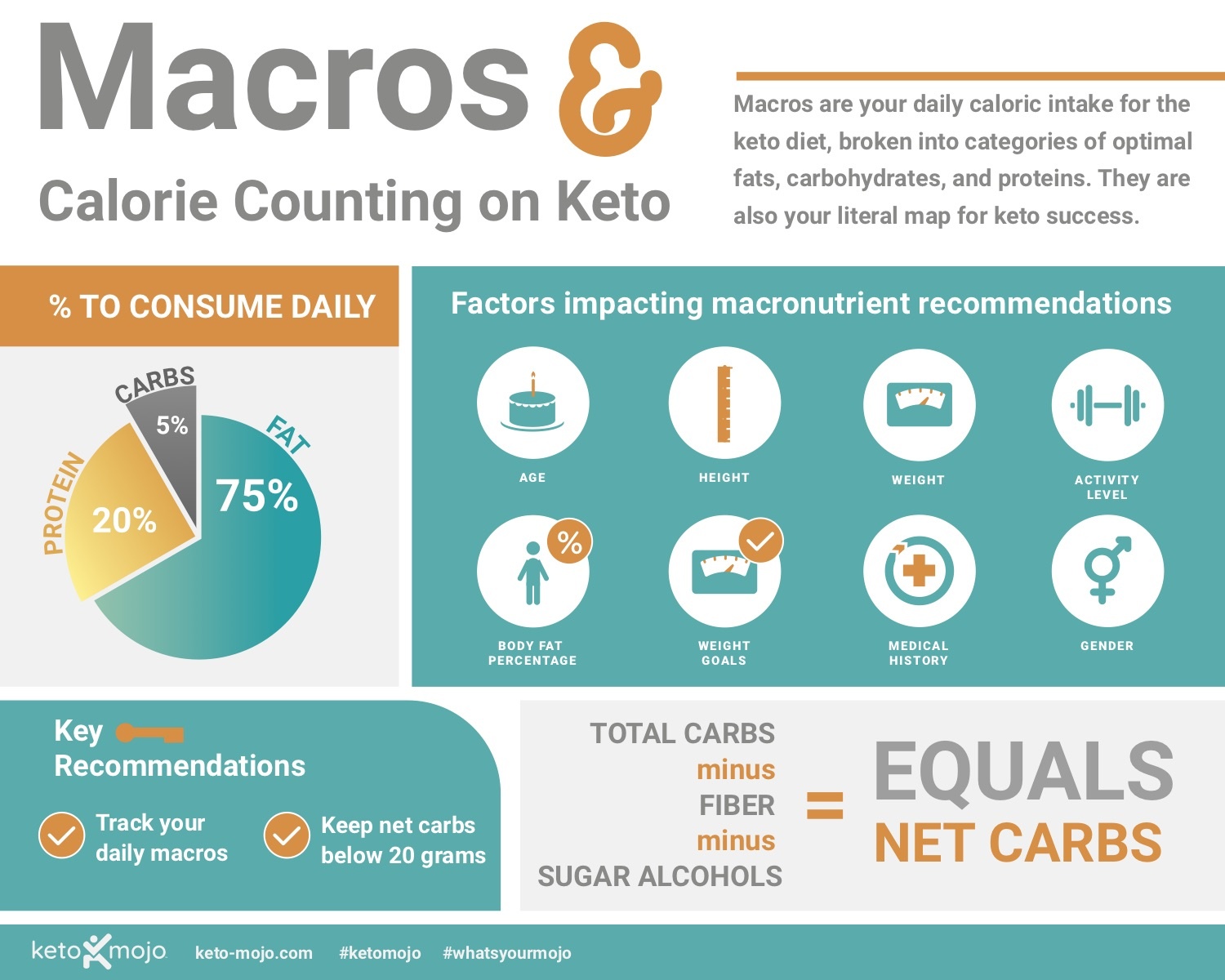Whether you’re following the ketogenic diet or just starting to learn about it, you’ve probably heard the term “tracking macros” or “counting macros.” But what exactly does it mean to track or count macros?
The term “macros” is short for “macronutrients,” which are the three major nutrients in our diet: carbohydrates, protein, and fat. (By contrast, vitamins and minerals are micronutrients.)
In recent years, tracking macros has gained popularity, thanks in part to the keto diet. Why? Because the keto diet is based on eating large amounts of good fats, eating moderate amounts of protein, and drastically reducing your carbohydrate intake so that your body burns fat for energy instead of glucose.
But along with eating more fat and fewer carbs, it’s also about consuming the right amounts of each macro based on your goal to lose fat or even maintain your weight.
Maybe your main goal is to lose body fat and maintain or gain muscle. Or perhaps you have certain health goals, like reversing diabetes, maintaining a healthy weight, or using ketosis as adjunct therapeutic treatment for a medical condition.
Either way, this is where “macros” come in.
How to Calculate Macros
The optimal amount of macros is different for each person, based on age, height, weight/body composition, activity level, body fat percentages (this is different than BMI), and weight goals.
How do you know what your optimal macros should be? The easiest way to determine the correct amounts is to use a macro calculator like the MyMojoMacros calculator. Just input the requested information (such as your current weight, age, gender, et cetera) and it will calculate the breakdown of calories, protein, carbs, and fat needed for you to lose, gain, or maintain your weight, depending on the health goals you set. (Expect a calorie deficit if you want to lose weight.)
The amount of “net carbs” required to stay in ketosis differs from person to person, independent of calorie intake. Although 20 or fewer grams of net carbs is often recommended, you may be able to consume more than this and remain in ketosis. Testing your ketone levels is key for determining your personal carb tolerance.
Note: Factors such as age, gender, family and personal medical history, and genetics influence how your body responds to specific macronutrient amounts. For this reason, we recommend you discuss your intended diet with a medical provider or registered dietitian who knows your health history, understands the ketogenic diet, and can help you make choices that are best for you.
How to Track Your Macros
Once you know your macros, you should count (track) them to give yourself the best chance to get and keep your body in a ketogenic state.
This means keeping a tally of the total calories, fat, protein, and “net carbs” for everything you eat and drink each day to ensure you don’t surpass your daily goals.
Yes, it’s a bit of work, especially if you want to lose weight and make sure your eating habits support ketosis. You’ll need to read nutrition labels, ideally focus on whole foods, monitor portion sizes, and perhaps use a food scale and macros tracking app to make sure your calculations are precise (more on this below). And, yes, everyone gets off track now and then. But don’t be discouraged––it’s all part of the journey! And after a while, it really does become second nature.
We know from experience that it’s easy to fool yourself into thinking you’re eating within your macros when you’re actually exceeding them. We also know that once you start keeping track and eating to your macros, you’ll find you’re less hungry over time, have more stable blood sugar levels, and achieve far better overall success. Plus, it’s kind of fun, and definitely empowering, to see cool charts and graphs of your daily food intake.
You can manually track your daily macros intake or calculate your totals using an app, such as Cronometer, MyFitnessPal, or Carb Manager (see our review on keto apps here) or an online recipe analyzer like the one at Happy Forks (NOTE: If you purchase the Keto-Mojo Promo Bundle, you’ll receive a 20% discount off the Cronometer Gold subscription).

What Are Net Carbs?
Simply put, “net carbs” are the total grams of carbohydrates in any given food minus its grams of fiber and the sugar alcohol erythritol. Here’s the basic formula:
Net carbohydrates = total carbohydrates – fiber – sugar alcohols (if applicable).
If you are not familiar with sugar alcohols, we tell you all about them here.
Here’s an example of the net carb calculation, using a medium avocado, which, incidentally, does not contain sugar alcohols:
A medium avocado contains 17.1 grams of total carbs and 13.5 grams of fiber. So, to get its net carbs, you subtract the fiber (13.5 grams) from the total carbs (17.1 grams), which leaves you with 3.6 grams of net carbs (i.e., 17.1 grams carbs – 13.5 grams fiber = 3.6 grams net carbs for 1 medium avocado). Talk about a reason to enjoy guacamole!
You can read more about the difference between total carbs and net carbs here.
What Now?
Now that you know about calculating macros, you have the power to set your daily intake of macros to manage your body weight, achieve and maintain ketosis, and begin or continue your journey to achieving better health and well-being.




